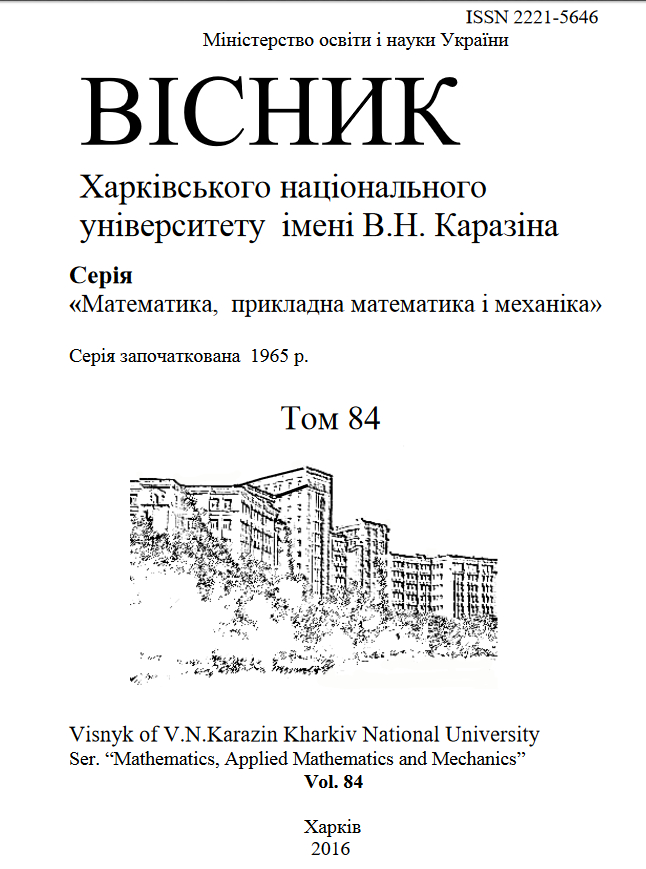Homogenization of the diffusion equation in domains with the fine-grained boundary with the nonlinear boundary Robin condition
Downloads
References
Cabarrubias B., Donato P. Homogenization of a quasilinear elliptic problem with nonlinear Robin boundary condition // Applicable Analysis: An International Journal, 2012.-- Vol. 91, №6.-- P. 1111-- 1127.
Chourabi I., Donato P. Homogenization and correctors of a class of elliptic problems in perforated domains // Asymptotic Analysis, 2015.-- № 92, P. 1-- 43.
Chourabi I., Donato P. Homogenization of elliptic problems with quadratic growth and nonhomogenous Robin conditions in perforated domains // Chinese Annals of Mathematics, 2016.-- Vol. 37B, №6.-- P. 833-- 852.
Cioranescu D., Donato P. On Robin problems in perforated domains //Mathematical sciences and applications, 1997.-- № 9.-- P. 123-- 135.
Cioranescu D., Donato P., Zaki R. Asymptotic behaviour of elliptic problems in perforated domains with nonlinear boundary conditions // Asymptotic Analysis, 2007.-- № 53.-- P. 209-- 235.
Conca C., Diaz J., Linan A., Timofte C. Homogenization in chemical reactive floes // Electronic Journal of Differential Equations, 2004.-- № 40.-- P. 1-- 22.
Conca C., Diaz J., Linan A., Timofte C. Homogenization results for chemical reactive flows through porous media // New Trends in Continuum Mechanics, 2005.-- № 6.-- P. 99~-- 107.
Conca C., Diaz J., Timofte C. On the homogenization of a transmission problem arising in chemistry // Romanian Reports in Physics, 2004.-- Vol. 5, №4.-- P. 613-- 622.
Goncharenko M. The asymptotic behaviour of the third boundary-value problem solutions in domains with fine-grained boundaries // Mathematical sciences and applications, 1997.-- № 9.-- P. 203-- 213.
Mel'nyk T.A., Sivak O.A. Asymptotic analysis of a boundary-value problem with the nonlinean multiphase interactions in a perforated domain // Ukrainian Mathematical Journal, 2009.-- Vol.61, № 4.-- P. 494-- 512.
Mel'nyk T.A., Sivak O.A. Asymptotic approximations for solutions to quasilinear and linear elliptic problems with different perturbed boundary conditions in perforated domains // Asymptotic Analysis, 2011.-- № 5.-- P. 79-- 92.
Timofte C. On the homogenization of a climatization problem // Studia Universitatis <
Timofte C., Cotfas N., Pavel G. On the asymptotic behaviour of some elliptic problems in perforated domains // Romanian Reports in Physics, 2012.~-- Vol.64, № 1.-- P. 5-- 14.
Berlyand L.V., Khruslov E.Ya. Competition between the surface and the boundary layer energies in a Ginzburg-Landau model of a liquid crystal composite // Asymptotic Analysis, 2002.-- № 29.-- P. 185~-- 219.
Марченко В.А., Хруслов Е.Я. Усреднённые модели микронеоднородных сред.-- К: Наукова думка, 2005.-- 551 с.
Cabarrubias B., Donato P. Existence and Uniqueness for a Quasilinear Elliptic Problem With Nonlinear Robin Condition // Carpathian Journal of Mathematics, 2011.~-- Vol.27, № 2.-- P. 173-- 184.
Хруслов Е.Я. Асимптотическое поведение решений второй краевой задачи при измельчении границы области // Математический сборник, 1978.~-- Т.106(148), № 4(8)}.-- С. 604-- 621.
Владимиров В.С. Обобщённые функции в математической физике.-- М.: Наука, 1979.-- 320 c.
The copyright holder is the author.
Authors who publish with this journal agree to the following terms:
1. Authors retain copyright and grant the journal right of first publication with the work simultaneously licensed under a Creative Commons Attribution License that allows others to share the work with an acknowledgement of the work's authorship and initial publication in this journal. (Attribution-Noncommercial-No Derivative Works licence).
2. Authors are able to enter into separate, additional contractual arrangements for the non-exclusive distribution of the journal's published version of the work (e.g., post it to an institutional repository or publish it in a book), with an acknowledgement of its initial publication in this journal.
3. Authors are permitted and encouraged to post their work online (e.g., in institutional repositories or on their website) prior to and during the submission process, as it can lead to productive exchanges, as well as earlier and greater citation of published work (see The Effect of Open Access).




